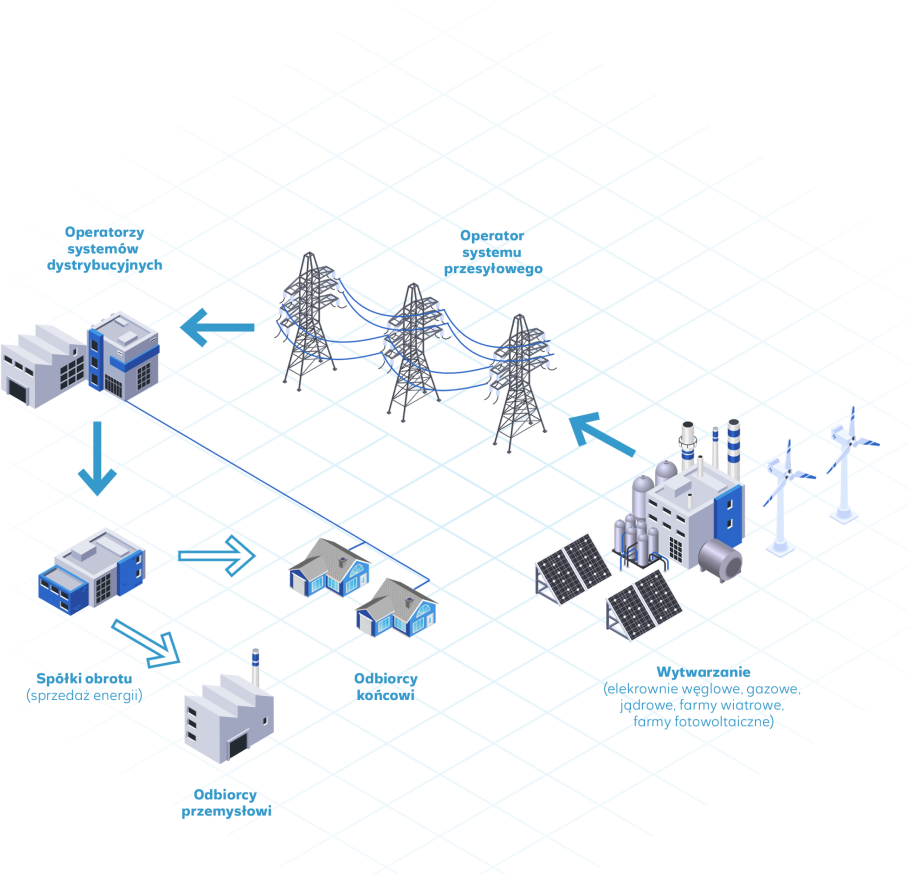
Power Energy
Market
Market
Electric Power Production
Electricity in Poland is generated in power plants, combined heat and power plants, and renewable energy sources. Energy distributors conduct two independent types of activities: energy trading and its transport through distribution networks. The transport of energy from producers to final consumers takes place via two types of networks, owned by different entities: transmission networks and distribution networks.

Segmentation of the Electricity Market
Electricity trading in Poland takes place in three main market segments: the contract market, the exchange market, and the balancing market.

Wholesale Market
The vast majority of electricity generation is still based on conventional fuels, namely hard coal and lignite. However, the share of wind power and other renewable energy sources continues to grow.
For producers, the main forms of electricity sales include sales within regulated markets, where the energy exchange plays a dominant role, as well as sales to trading companies. For trading companies, electricity is primarily sold to other trading companies and end consumers. To a lesser extent, but still significantly, sales are also directed to the energy exchange.
For producers, the main forms of electricity sales include sales within regulated markets, where the energy exchange plays a dominant role, as well as sales to trading companies. For trading companies, electricity is primarily sold to other trading companies and end consumers. To a lesser extent, but still significantly, sales are also directed to the energy exchange.

Retail Market
Participants in the retail market, in addition to end consumers (both households and businesses), include companies managing the distribution network, such as distribution system operators (DSOs) and electricity suppliers (trading companies).
The IRiESD (Distribution Network Operation and Maintenance Instructions) play a significant role in the functioning of the retail market. These instructions define the rules for operating the retail electricity market, including the procedure for changing suppliers, the principles for determining and transmitting measurement data by DSOs, the process for changing entities responsible for trade balancing, and the procedures to follow in the event of households losing their current electricity supplier.
The IRiESD (Distribution Network Operation and Maintenance Instructions) play a significant role in the functioning of the retail market. These instructions define the rules for operating the retail electricity market, including the procedure for changing suppliers, the principles for determining and transmitting measurement data by DSOs, the process for changing entities responsible for trade balancing, and the procedures to follow in the event of households losing their current electricity supplier.
Market Participants


The Process of Changing Electricity Suppliers
01
Conclusion of a Contract with a New Supplier
To ensure continuity of energy supply, the new contract should take effect on the day following the expiration of the current sales agreement with the existing supplier.
02
Termination of the Sales Agreement with the Current Supplier
The first change usually involves terminating the so-called comprehensive agreement, which covers both the terms of energy sales and the provision of distribution services.
03
Conclusion of a Distribution Service Agreement (this step may be carried out by the new supplier)
In the case of terminating a comprehensive agreement, a new distribution service agreement with the distribution system operator (DSO) must be signed. This agreement comes into effect on the day following the termination of the previous comprehensive agreement. Such an agreement can be concluded for an indefinite period. It does not need to be terminated or re-signed during subsequent supplier changes.
04
Informing the DSO about the Conclusion of a New Sales Agreement (this step is performed by the new supplier)
The notification must comply with the standards adopted by the relevant DSO. Based on the received information, the DSO, within no more than 5 business days from the date of receiving the supplier change request, performs a formal verification and checks whether the customer is located in its area and is billed within its billing system. Upon verification, the DSO sends confirmation of the registration of the request to the customer and the new supplier or issues a rejection due to: missing or incorrect data in the request, lack of a general agreement with the supplier, or another formal reason. If the verification results in a negative outcome, the supplier change procedure will be interrupted and must be repeated after the issues causing the negative verification are resolved.
05
Conclusion of a Distribution Service Agreement (this step may be carried out by the new supplier)
After changing the electricity supplier, it may be necessary to adapt the metering and billing system. The obligation to adjust the metering and billing system lies with its owner (for tariff groups A and B, the system owner is the consumer, while for tariff group C, the owner is the distribution system operator (DSO)).
06
Final Settlement with the Current Supplier
The meter reading takes place on the day of the supplier change, which is the effective date of the new sales agreement. The reading is carried out by the distribution system operator (DSO). The operator provides the meter status (as of the supplier change date) to both the previous and the new supplier within a specified timeframe. Based on this, the final settlement is prepared by the previous supplier.
 pl
pl